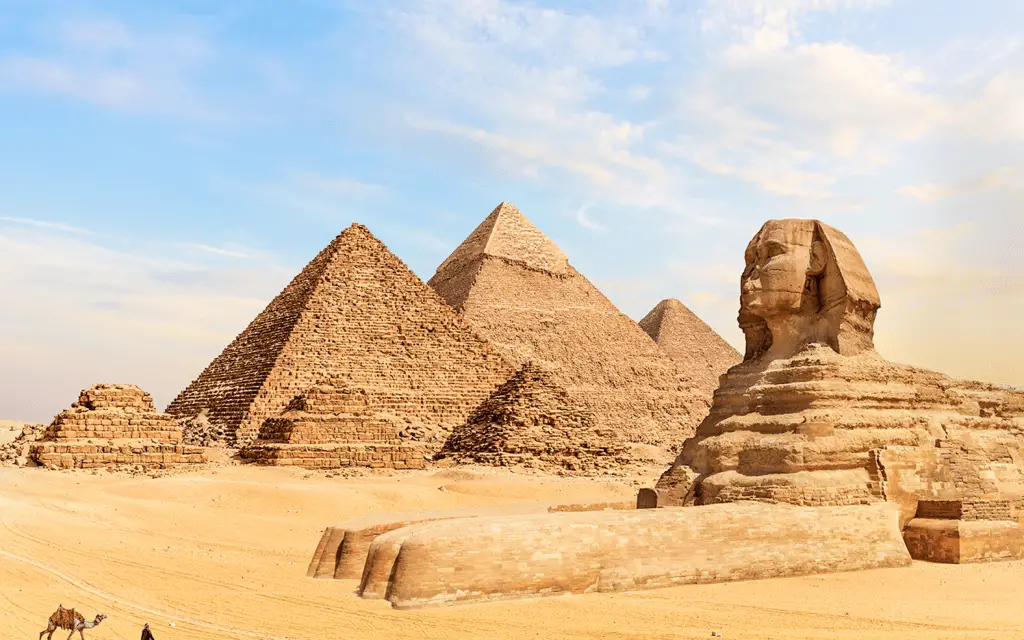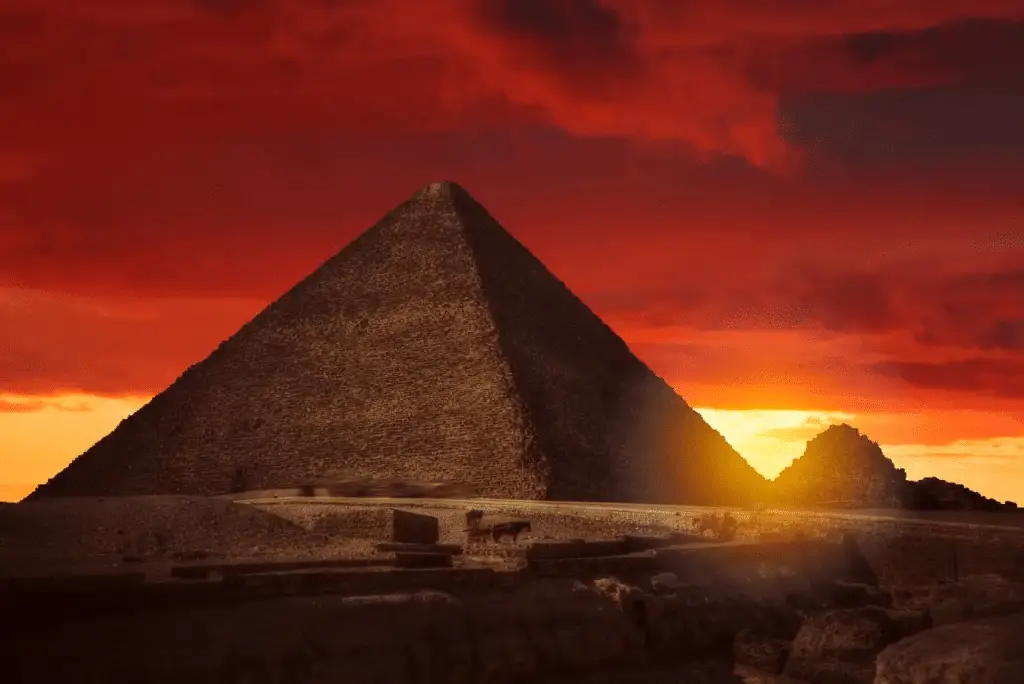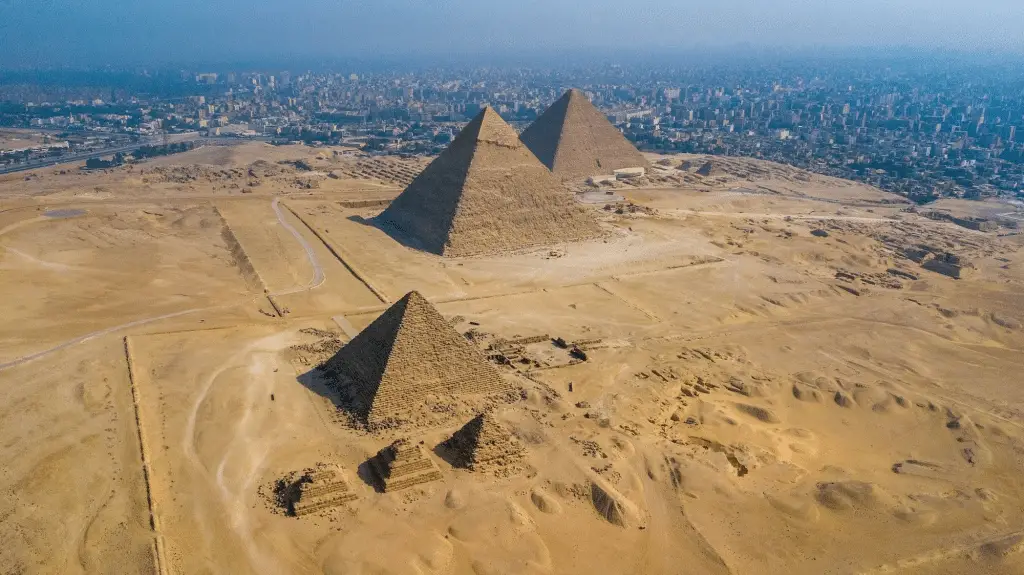There Great Pyramid of Gizaone of seven wonders of the ancient worldhas fascinated humanity for millennia. Built during the reign of Pharaoh Cheops (Khufu) around the 2580-2560 BCthis colossal structure is not only a symbol of ancient engineering, but also an archaeological enigma that continues to arouse curiosity and wonder.
Despite two centuries of archaeological excavations and investigations, only a few objects have been recovered from inside the Great Pyramid of Giza, making each discovery a momentous event.
The History of the Great Pyramid of Giza
The pyramid, originally about 146.6 meters highis composed of approximately 2.3 million stone blockseach weighing on average 2.5 tonsIts construction required extraordinary organization and manpower, with estimates speaking of tens of thousands of workers engaged for over two decadesbut beyond its impressive physical structure, what makes the Great Pyramid of Giza truly fascinating are the mysteries it holds within.
In 1872, British engineers Waynman Dixon And James Grant made a remarkable discovery inside the pyramid: three small objects, collectively known as the “Dixon Wrecks”. These artifacts, which include an iron hook, a piece of cedar wood, and a granite sphere, are among the very few objects ever recovered from inside the pyramid, the discovery of which raised numerous questions about their origin and purpose, questions that remain largely unanswered today.
The discovery of the Dixon Wrecks has opened new perspectives on the understanding of the Great Pyramid of Giza and the techniques used in its construction, the iron hook, for example, suggests that the ancient Egyptians possessed advanced metallurgical knowledgewhile the piece of cedar wood could provide valuable clues about the dating of the pyramid through dendrochronological analysis.
However, despite the importance of these finds, their exact function and why they were found inside the pyramid remain shrouded in mystery.
Aside from the Dixon Wrecks, the Great Pyramid of Giza has revealed few other secrets; its internal chambers, including the King’s Chamber, the Queen’s Chamber and the Grand Gallery, have been the subject of numerous explorations, but most questions remain unanswered.

For example, the purpose of the so-called “air ducts” which extend from the internal chambers towards the outside of the pyramid is still under debate among scholars, with some believing they were used for ceremonial or religious purposes, while others hypothesize that they had a practical function related to ventilation or astronomical orientation.
The Great Pyramid of Giza continues to be a symbol of mystery and wonder, a monument that invites us to explore and uncover the secrets of the past, where each new discovery, however small, adds a piece to the puzzle of our understanding of Egyptian civilization and its extraordinary achievements.
The Great Pyramid of Giza is not only an imposing monument, but also a labyrinth of passages and chambers that have fascinated explorers and archaeologists for centuries, with the first documented explorations dating back in the medieval erawhen the Arab caliphs attempted to penetrate its depths in search of hidden treasures.
However, it was only in the 19th century that systematic explorations began to reveal the pyramid’s secrets.
One of the most famous explorers was the British Colonel Richard William Howard Vysewho conducted a series of excavations and research inside the pyramid in 1837. Vyse used dynamite to open new passages and discover hidden chambers, a method that today it would be considered highly destructivedespite this his discoveries were significant, including the King’s Chamber and the Queen’s Chamber, which contain sarcophagi and other finds of great historical importance.
Another important discovery was made in 1993, when the German archaeologist Rudolf Gantenbrink used a robot to explore the pyramid’s so-called “air ducts.” The robot, called Upuut 2discovered a small stone door at the end of one of the shafts, raising new questions about the purpose of these passages.

In 2011, another robot, Djediwas sent to further explore the shafts of the Great Pyramid of Giza and found that the stone door had copper handles, suggesting that it may have been a functional door rather than a simple stone block.
Theories and hypotheses on the construction
The construction of the Great Pyramid of Giza has been the subject of numerous theories and hypotheses, one of the most debated questions is how the ancient Egyptians managed to transport and position the massive stone blocks. Some scholars suggest that they were used earth or stone rampswhile others hypothesize the use of levers and counterweights.
Recent discoveries Archaeological excavations have revealed the presence of an ancient port near the pyramid, suggesting that the stone blocks may have been transported by water along the Nile.
Another interesting theory concerns the alignment of the pyramid with the cardinal points, the ancient Egyptians in fact were known for their advanced astronomical knowledgeand some scholars believe that the pyramid was precisely aligned to reflect significant celestial events: the air shafts of the King’s Chamber are thought to have been oriented toward the stars of Orion’s Belt, which were associated with the god Osiris.
Implications of recent discoveries
Recent discoveries have had a significant impact on our understanding of the Great Pyramid of Giza and Egyptian civilization, for example the analysis of cedar wood found among the Dixon Wrecks has allowed us to to date the construction of the pyramid more preciselyconfirming that it dates back to the reign of Cheops.
In addition to the above, the discoveries made by the robot explorers in the air ducts have raised new questions about the purpose and function of these passagessuggesting that they may have ceremonial or religious significance.

Modern technologies, such as laser scanning and computed tomography, are opening up new possibilities for exploring the pyramid without damaging it.
These techniques allow us to create detailed maps of the interior of the pyramid and identify any hidden chambers or passages that have not yet been discovered. For example, in 2017 a team of researchers used muon tomography to discover a large cavity inside the pyramid, which could represent a new room not yet explored.
The Great Pyramid of Giza continues to be a symbol of mystery and wondera monument that invites us to explore and uncover the secrets of the past, and each new discovery, however small, adds a piece to the puzzle of our understanding of Egyptian civilization and its extraordinary achievements.
Modern technologies are opening up new possibilities for exploring the pyramid, allowing us to unlock its secrets without damaging it, and in the coming years, we can expect new discoveries to continue shedding light on this extraordinary monument and the civilization that built it.
If you are attracted by science or technology, keep following us, so you don’t miss the latest news and updates from around the world!
#Great #Pyramid #Giza #True #Beauty
